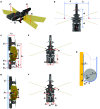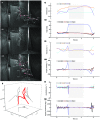An Aerial-Wall Robotic Insect That Can Land, Climb, and Take Off from Vertical Surfaces
- PMID: 37228637
- PMCID: PMC10204747
- DOI: 10.34133/research.0144
An Aerial-Wall Robotic Insect That Can Land, Climb, and Take Off from Vertical Surfaces
Abstract
Insects that can perform flapping-wing flight, climb on a wall, and switch smoothly between the 2 locomotion regimes provide us with excellent biomimetic models. However, very few biomimetic robots can perform complex locomotion tasks that combine the 2 abilities of climbing and flying. Here, we describe an aerial-wall amphibious robot that is self-contained for flying and climbing, and that can seamlessly move between the air and wall. It adopts a flapping/rotor hybrid power layout, which realizes not only efficient and controllable flight in the air but also attachment to, and climbing on, the vertical wall through a synergistic combination of the aerodynamic negative pressure adsorption of the rotor power and a climbing mechanism with bionic adhesion performance. On the basis of the attachment mechanism of insect foot pads, the prepared biomimetic adhesive materials of the robot can be applied to various types of wall surfaces to achieve stable climbing. The longitudinal axis layout design of the rotor dynamics and control strategy realize a unique cross-domain movement during the flying-climbing transition, which has important implications in understanding the takeoff and landing of insects. Moreover, it enables the robot to cross the air-wall boundary in 0.4 s (landing), and cross the wall-air boundary in 0.7 s (taking off). The aerial-wall amphibious robot expands the working space of traditional flying and climbing robots, which can pave the way for future robots that can perform autonomous visual monitoring, human search and rescue, and tracking tasks in complex air-wall environments.
Copyright © 2023 Qian Li et al.
Figures






References
-
- Karásek M, Muijres FT, Wagter CD, Remes BDW, Croon GCHE. A tailless aerial robotic flapper reveals that flies use torque coupling in rapid banked turns. Science. 2018;361(6407):1089–1094. - PubMed
LinkOut - more resources
Full Text Sources

